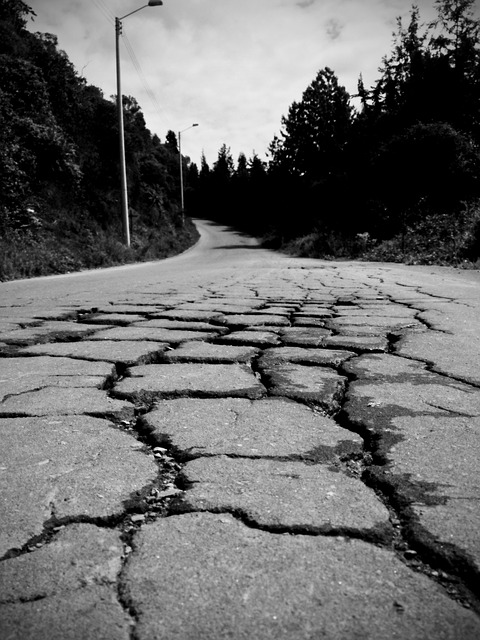.................................................................................................................................................
By: Haseeb
Jamal
The common causes of pavement deterioration and
degradation are overloading, seepage, improper or poor road
surface drainage, lack of proper road
maintenance, lack of proper design, adverse climatic conditions and
some other factors.
They also cause an increase in fuel costs, result in time
delay and prove troublesome for every road user.
Identification of the road cracks at an
early stage is essential as preventive road maintenance and effective remedial
measures can be applied before the problem becomes too severe and the pavement
fails.
Also, the distresses whether of a smaller or larger scale
are a nuisance to the road users and may prove hazardous if neglected for a
long period as their condition worsens with time.
Proper, timely and selective road
maintenance thus becomes an important principle which lengthens
the life of the pavement and also reduces the cost of maintenance.
Common Road Distresses in Flexible
Pavements:
The most common road distresses in flexible pavements are
Cracking and Rutting.
Type of Road Cracks
Fatigue or Alligator Cracking:
 Fatigue cracks are interconnected cracks that are caused
under the influence of repeated traffic
loading.
Fatigue cracks are interconnected cracks that are caused
under the influence of repeated traffic
loading.
Roads that face extreme climates and heavily loaded
vehicles undergo severe fatigue cracking.
It is also referred to as Alligator cracking as the crack
pattern resembles the skin of an alligator.
Fatigue cracking if not attended causes roughness and may
lead to structural failure, water seepage through the cracks and can further
degrade to form potholes.
Block Cracking in Roads:
Block cracking is in the form of interconnected
rectangular cracks. These types of cracks also cause roughness and water
seepage through the cracks.
Longitudinal and Transverse cracking:
Cracks formed in the direction of the traffic flow are
termed as longitudinal cracks and those that are formed perpendicular to the
traffic flow are called transverse cracks.
Corrugation and Shoving:
It causes roughness and discomfort to the driver.
Depression:
Localized road sections with a slight depression, it
causes roughness and collects water which may lead to pothole formation
Potholes:
Potholes are bowl-shaped depressions of varying sizes in
the pavement surface. They generally have sharp edges. Potholes are most likely
to occur on roads with thin surfaces course.
They are usually caused when the severity of cracks
increases. They cause roughness and rider discomfort and are a major cause of
accidents especially at dark times when there visibility is very low.
Raveling:
The crumbling up of the asphalt layer as a result of the
disintegration between the aggregate particles and the asphalt binder.
It causes roughness and skid resistance problem and may
lead to pothole formation as the moisture infiltration increases because of the
openings.
Rutting:
It is identified as the slight depression along the wheel
paths in a pavement. It is classified into two types.
Mix rutting: when the rutting does not affect the subgrade and Subgrade
Rutting: When the rutting is prominent in the subgrade.
Water Bleeding:
Water bleeding occurs when water seeps out of joints or
cracks or through an excessively porous HMA layer.
Stripping:
The loss of bond between aggregates and asphalt binder
that typically begins at the bottom of the asphalt layer and progresses upward.
When stripping begins at the surface and progresses
downward it is usually called raveling.
Haseeb
Jamal. I am a Civil Engineer,
graduated from University
of Engineering and Technology, Peshawar, Pakistan in 2010. I also
have a PG-Diploma in Disaster Management and
MS in Urban
Infrastructure Engineering (In Progress). My expertise include civil
related softwares like AutoCAD,
SAP2000, MS Project, Primavera, MS Office and GIS. My technical skills include
project management, monitoring and evaluation, structural assessment, disaster
risk management, Quantity survey, land survey, material testing, site
management and technical writing. I am trained in writing project progress
reports as well as proposals and concept papers. I have also received advanced
training on surveying, proposal writing, Monitoring and Evaluation of projects
as well as organizations.
I have worked as Project
Engineer at National Research and Development Foundation, Peshawar and
CENCON Associates. I also worked with Spectra Engineering Solutions as Senior
Civil Engineer in monitoring of World Bank and UNDP funded projects all
over Khyber Pakhtunkhwa and FATA. Currently, I am working as Deputy
Manager Development at NayaTel, Peshawar.

No comments:
Post a Comment